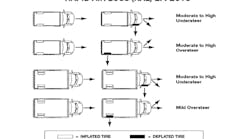Tires are one of the most critical components that need to be managed by vehicle fleet operators today. Not only can tires represent one of the largest maintenance issues, they also can have a significant effect on vehicle performance.
Many existing recommendations and procedures are rooted in decades-old experiences and technologies. Additionally, it is important to review all procedures from the standpoint of individual fleet makeup, duty cycle and operator/driver experience. What may be good for one fleet may not be optimal for another.
Sifting through federal and state (provincial) regulatory requirements will provide only minimal performance standards. Although those standards need to be met, they don’t paint an adequate picture of the numerous considerations that need to be managed in order to provide the best balance of performance objectives.
One of the major considerations a truck fleet faces on a day-to-day basis is where to position replacement tires when the time or need presents itself.
TIRE PROCEDURES
U-Haul operates the largest truck fleet in North America, with a total at any one time of close to 100,000 trucks. Of those, approximately 25 percent are four-wheel light duty trucks with gross vehicle weight ratings (GVWR) of less than 10,000 pounds. The remaining 75 percent are six-wheel medium duty trucks with a GVWR of up to 20,000 pounds.
These trucks are rented to individuals with diverse demographic backgrounds, not only from an experience level, but also from physical-operating environments.
U-Haul utilizes one of the most comprehensive and dynamic maintenance systems of any fleet operator today. Procedures and policies are updated on virtually a daily basis. Tire monitoring and replacement procedures are just one of the issues included in the overall process, and they are continually reviewed for optimal performance and safety.
A key question is whether to place the newest tire(s) on the front or on the rear of a vehicle. A survey of other U.S. fleet operators failed to indicate a clear and consistent policy. In many cases, this is attributable to diverse fleet composition, duty cycle, driver experience and personal preference.
Through an analysis, it was determined that from a vehicle dynamics standpoint, different policies were required for four-wheel and six-wheel trucks.
VEHICLE CONSIDERATIONS
Vehicle braking, cornering and traction are directly affected by tire condition. However, there appears to be no difference in requirements for four- or six-wheel trucks.
Additionally, it is felt that drivers can quickly adapt to individual vehicle capabilities within this category. Once drivers have familiarized themselves to a specific vehicle, they are able to use good judgment and safely operate.
Rapid air loss (RAL) presents one of the most significant conditions which must be considered when replacing tires on a vehicle. It is commonly understood that tires with reduced tread depth are more susceptible to punctures and major damage-inflicting road hazards which can cause rapid air loss including, but not limited to, what is commonly referred to as “blowouts.”
When a tire experiences a RAL, not only can the vehicle “kneel down” at the corner which suffered the RAL, but the tire/wheel combination itself also experiences increased resistance to rolling. Both of these factors cause a force vector which, combined with the forward-momentum vector, will cause the vehicle to deviate from its desired path. The effect of this deviation can differ significantly if the RAL occurs on the steer axle or the drive axle. (See illustration.)
STEERING CONDITIONS
For both four- and six-wheel vehicles, RAL on the steer axle can cause a moderate to high level of understeer. This is the tendency of a vehicle to steer less than the driver’s input would suggest.
Although levels of understeer vary from vehicle to vehicle, it tends to introduce a stabilizing effect on the vehicle’s dynamic performance. Many times this characteristic is referred to as “pushing” or “plowing.”
Within moderation, most drivers can overcome or adjust to this phenomenon by introducing more steer input toward the desired direction of travel. All modern cars and trucks are designed with a natural amount of understeer built in through suspension configuration and basic weight distribution.
When a RAL occurs on the rear of both four- and six-wheel vehicles, the lateral vector induces an oversteering effect. Oversteer is the tendency of a vehicle to turn more than expected in the desired path.
This condition can be very unstabilizing for the average driver and can catch a person by surprise. Most drivers are not trained to correct for this condition and in extreme cases, can overcorrect and subsequently lose control of the vehicle.
The degree of RAL may be significantly different in four- and six-wheel vehicles. In the case of a four-wheel vehicle, the tendency of the vehicle to “kneel” in the rear is significantly higher than that experienced with a six-wheel vehicle. This “kneeling” effect results in a higher tendency to cause an oversteer situation.
Additionally, the lateral stabilizing capability at the rear of a four-wheel vehicle is effectively reduced by 50 percent. A six-wheel vehicle will experience a loss of only 25 percent.
TIRE PLACEMENT
For U-Haul, customer safety is the number one priority, and tire placement is predicated by the need to maintain vehicle control under diverse conditions.
For this reason, it is much more important to mitigate a RAL situation on the rear of a four-wheel vehicle than it is to mitigate it on the rear of a six-wheel vehicle. This condition reinforces the need to maintain the “best” tires on the rear of a four-wheel vehicle if at all possible.
As mentioned previously, six-wheel vehicles do experience a similar situation, but to a much lesser degree.
Furthermore, since modern vehicles are designed with a certain amount of overall understeer, a slight amount of oversteer caused by RAL on the rear of a six-wheel vehicle will result in minimal disruption of controllability.
For this reason, it is more important to mitigate a RAL situation on the front of a six-wheel vehicle. Consequently, it is desirable to place the “best” tires on the front or steer axle of six-wheel vehicles.



